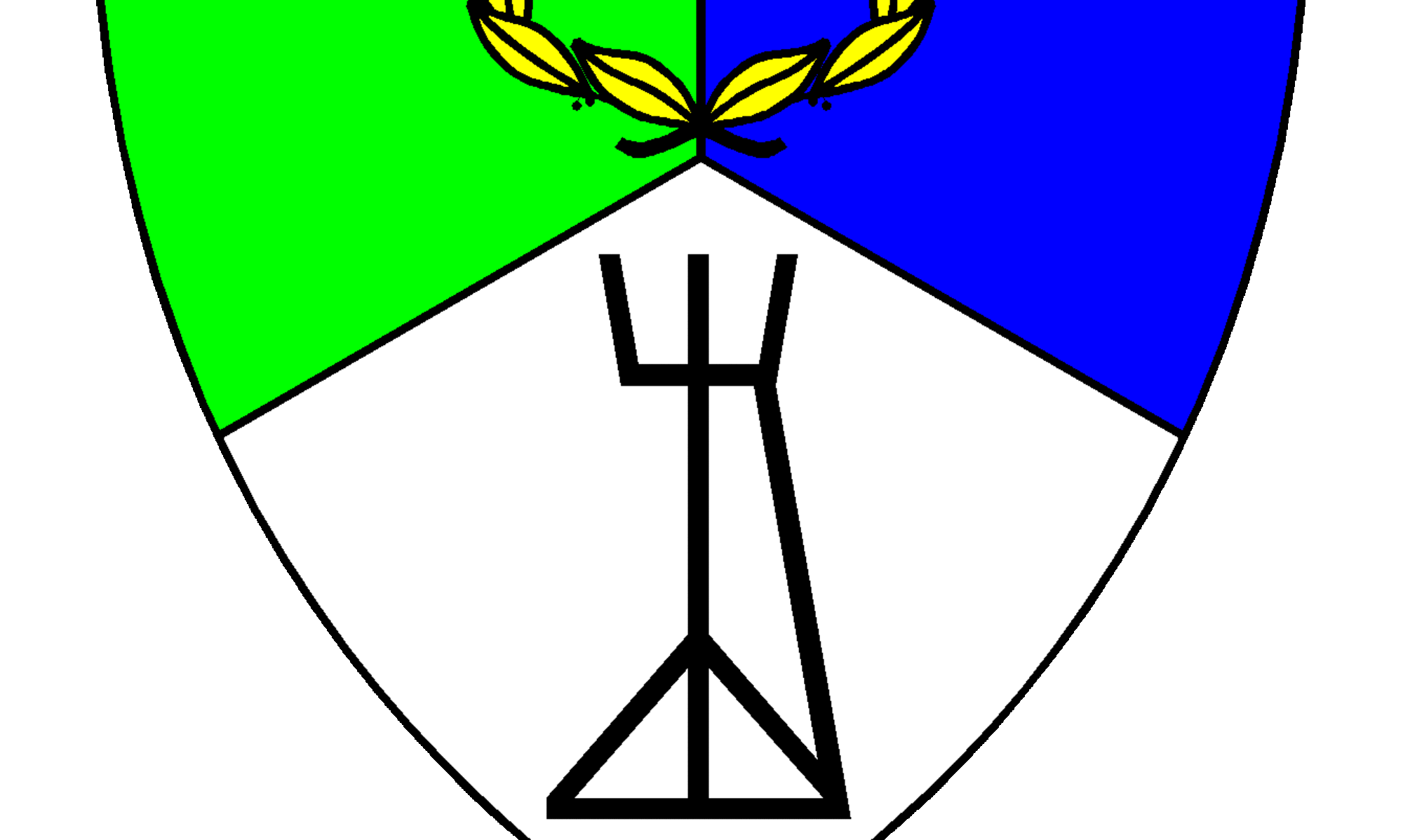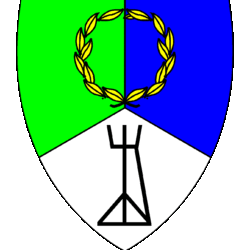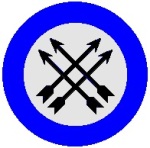ARCHERY by Lord Wynfrið æt Huntandune
Introduction
You stand poised at the line, the target…a wand at a distance of 35 yards. Heraldic banners flutter in the light breeze…it is a beautiful sunny day in the middle of August. You wait patiently for the marshal to declare the range clear and prepare to shoot…the other archers get ready too, fingers lightly touching the string of their bows in anticipation. This is the start of the annual Silver Arrow Archery Tournament at Foxworthy Manor…the prize – the coveted silver arrow! You glance quickly down the line, last year’s winner is at the other end, confident that she will walk away with the prize once again. Abruptly, the marshal calls “it’s clear down range – begin shooting”. Confidently, you draw your bow and take aim, muscles stretching, and in an instant, the arrow streaks toward the target…
A scene from a Robin Hood movie? Perhaps. But in this case, it is a real tourney at a local SCA event here in Pictou County. Archery is probably one of the first activities that you are likely to participate in when you join the SCA. It is also the one martial activity that just about everyone can take part in – adults and children of all ages, regardless of your physical condition or handicap. It is also one sport that just about anyone can do well in and compete on an equal footing. And the hitting the gold at the center of the target…or splitting the wand [a narrow pole stuck in the ground] is definitely a satisfying accomplishment.
One of the unique aspects of archery in the SCA is that it is, for the most part, a non-competitive sport. Much of the shooting is focused on a personal ‘best’ and almost all competitions are purely for fun…what we are essentially doing is reenacting an activity that was an integral and essential aspect of day-to-day life in the Middle Ages. So let your imagination go…you won the competition, and now you are called before Their Excellencies at Baronial Court to receive the token of your accomplishment…His Excellency compliments you on your prowess at the butts, and hands you the silver arrow as a momento of the honour and glory of this day!
A Historical Perspective
The bow and arrow has been the personal weapon of choice throughout the ages, and evidence of its use goes back well beyond 5000 B.C. The bow stands uniquely by itself as an effective and highly efficient hunting weapon and has been used continuously throughout the ages by most cultures, both primitive and modern. Early military records concerning the use of the bow have been recorded from countries throughout Europe, the Middle East and the Far East and has figured prominently in the success of numerous military campaigns throughout history. Although in modern times, the role of the bow has been virtually replaced by the use of gunpowder, it still remains the favorite weapon of many sportsmen. In fact, the bow, in its most primitive form, has been used to hunt big game throughout the world, including the African elephant.
References to the use of the bow as an important military weapon come from most of the early civilizations in Europe and Asia. In the context of the time period covered by the SCA (500 – 1600 A.D.), the bow first gives rise to prominence as an effective military weapon in the 11th century during the Norman invasion of England in 1066. As the story goes, the Saxon King of England, known as Edward the Confessor, died without an heir in the spring of 1066. The English Witan [ruling council] decided to name Harold, the powerful Earl of Wessex who was a Saxon, as the successor to William. However, through his connections with Edward the Confessor, William the Duke of Normandy expected to assume the crown of England. William decided immediately to invade England and take the crown. On October 14, 1066, the Norman army consisting primarily of archers and mounted troops met King Harold and his army of foot-soldiers who were armed with battle axes at Hastings in southern England. The English army was initially successful in holding off the Norman invaders, but as the battles wore on, and through a series of rouses by the Normans, the English troops began to suffer unyielding losses at the hands of the Norman archers who were using longbows. The battle that insued was soon over when King Harold died as a result of being hit in the eye by an arrow. Duke William was then crowned William I, King of England, and henceforth is remembered throughout history as William the Conqueror.
The longbow went on to prove its worth in other famous battles in the ensuing years both in the British Isles as well as on the continent and was instrumental in facilitating key turning points in the political history of more than one nation. Other variants of the bow such as the composite recurve bows, or Turkish bows, of the Middle East and the numerous variants used by military forces in the Far East, including Japan and China, were equally important in the political struggles of other countries throughout the Middle Ages.
Archers to the Line!
Like any recreational sport, archery in the SCA is meant to be fun. There are two main stipulations however and these include 1) a strict adherence to safety, and 2) all equipment should adhere to the spirit of mediæval archery. Apart from this, the amount of fun you can have will only be limited by your imagination, and whether you are a beginner, or an expert, the challenges are unlimited.
With regard to safety, all shooting done at any official SCA events, including practices and competitions, must be coordinated and run by a trained archery marshal. Archery marshals will inspect equipment to make sure that it is safe to use, and coordinate the running of the lines to ensure the safety of all those present, including participants and spectators alike. In this regard, there is a stringent set of written policies which sets the guidelines, both for archers and marshals alike, governing the standards, requirements and responsibilities of all archers in the Society.
With respect to equipment, only traditional style bows and arrows are used. This means that we do not use modern compound bows or crossbows, sighting mechanisms, or releases, etc. and arrows must be made of wood with natural feathers. All other styles of bows including recurves, longbows, selfbows, crossbows, and various composite bows reflecting the style and types of equipment used during the Middle Ages are fine. Modern materials in the construction of the bows is also perfectly exceptable as long as the finished bows maintain the appearance of their mediæval counterparts.
There are several levels of recognition for proficiency with the bow based on a standardized shoot referred to as the Royal Round. This is essentially a ranking system that is designed to provide individual archers with a method to compare individual skill levels. The ranking system is based on the average of the three highest Royal Round scores submitted to the Archery Scorekeeper within the previous twelve months. Scores are based on a shoot using the NAA-FITA standard 5 colour, 60 centimeter round targets and consisting of one end of 6 arrows shot at measured distances of 20, 30, and 40 yards, and a 30 second speed round at 20 yards. These rankings and their respective titles are as follows:
Archers are awarded an archery badge for each level of achievement (shown above). Archers who achieve the rank of Grand Master Bowman also receive an illuminated scroll in addition to the archery badge.
Other archery competitions include the Inter Kingdom Archery Competition (IKAC), various Baronial, Principality, and Kingdom level archery championships, and numerous other local competitions such as the annual Silver Arrow Archery Tournament mentioned above. Any one of these competitions will comprise a variety of different types of shoots such as the following:
Prycke shoot (common in a mediæval tournament)
Helme shoot (a cardboard mockup of a helm placed on a stake)
The wand (a stake at some distance as often seen on Robin Hood movies)
Slot shoots (variations on hitting a narrow opening typically seen on castle walls)
Clout shoots (long distance shooting of at least 100 yards)
Advancing warriors (timed shoots at mockups of knights at various distances)
Equipment
So maybe you would like to give this archery thing a try! Like most recreational activities however, there is some basic equipment that you are going to need. Besides a bow and some arrows, you should also have a shooting glove, an arm guard, and a quiver. In this regard, most SCA groups have loaner gear on hand for those that want to try some shooting before heading for the archery shop. Unless you have some previous experience with archery, this is probably a good thing to do as it affords you the opportunity to have a look at some of the equipment and ask questions, as well as try your hand at shooting to see if this is really for you.
The following is a brief discussion on the equipment you will need, along with prices and some general comments. Prices are quoted in Canadian dollars.
1) Bows
Fibreglas – $40-70+ (not recommended unless you can find a true recurve)
Wood – $150-250 for entry level bows (there are some excellent ones)
If you are serious about getting involved in archery, I would strongly suggest that you consider one of the well known entry level bows that are available from several different manufacturers. You will also have to decide on the type of bow that you would like to shoot. In this regard, recurve bows tend to be more forgiving and easier to shoot than other types of bows such as the longbow or the various types of self bows or flat bows. Recurve bows are generally easier to draw (they stack less), and because they have a fairly deep shelf, are closer to being center-shot and less subject to what is referred to as the ‘archer’s paradox’. Many archers find that other types of bows, particularly the longbow, are more difficult to shoot accurately and take longer to learn to shoot well. Lastly, a word of advice…don’t get a bow that is too difficult for you to draw and hold! For the type of shooting that is done in the SCA, most archers should consider a bow ranging in draw weight between 30 and 40 lbs depending on their draw length and upper body strength. In this regard, the average draw weight of bows used in the SCA is generally in the 30-35 lb range, for both men and woman! Bear in mind that the efficiency of a given bow can be a significant factor when choosing a particular draw weight. In this regard, a very efficient 30 lb bow with good cast can outshoot, in terms of trajectory and accuracy (depending on the skill of the archer), bows with heavier draw weights that are inefficient with poor cast.
Used bows will range $10-30 for fibreglas bows and approximately $75-150 for wood bows. Used bows should always be checked carefully before buying…look for warps, checks and breaks in the laminations, previous repairs that may be suspect, and general overall condition. This should be done in both strung and unstrung condition. If you have any doubts, ask a local archery marshal to check it out for you.
2) Arrows
If there is one area of your archery equipment that should not be compromised, it is your arrows! In order to shoot well, your arrows need to be carefully matched to a) the bow that you are using, and b) your shooting style and form. In this regard, two things need to be considered. First, a properly selected arrow can be shot accurately out of just about any bow; an improperly selected arrow will not shoot right out of any bow, regardless of price. Secondly, an arrow that shoots well out of your bow will probably not perfrom the same if shot by someone else using the same equipment. The main factors that need to be considered when selecting arrows include the draw weight of your bow, draw length, and your overall shooting style. The best thing here is to talk to an experienced archer for advice.
Arrows are usually purchased in sets of 12 that are matched according to overall weight and spine (stiffness), and will cost in the vicinity of $75-100 a dozen depending on the materials used and construction methods. Matched arrows can be purchased from any number of commercial sources or they can be custom made by fletchers within the SCA. In fact, many archers make their own arrows! Again, check with a local archery marshal for more information.
3) Shooting gloves
A shooting glove for your string hand will cost in the vicinity of $12-18 depending on its overall quality and materials used. Most shooting gloves have a similar design and are made of some type of leather – the main difference is in the thickness. Some archers prefer a thick glove to protect their fingers, particularly with heavier bows, while others prefer a thinner design that allows them to ‘feel’ the string. Less expensive finger tabs are also available but are generally ackward to use.
4) Arm Guards
An arm guard is generally recommended for most archers to protect them from the inevitable slap from the bow string as it is released. Although this is not necessarily a problem for those that shoot a recurve bow, anyone who shoots a longbow will find an arm guard to be an absolute necessity. A particularly useful aspect of an arm guard is that it will help to keep loose clothing out of the way of the bow string as it is released. Arm guards will cost in the range of $10-15 but can be easily made from a small piece of leather and a bit of lacing.
5) Quivers
There are basically two main types of quivers used by archers in the SCA – the back quiver and the side quiver. The back quiver keeps the arrows well out of the way and provides a moderate speed advantage when removing arrows from the quiver, particularly during a speed round. Some people find it difficult to easily remove arrows from a back quiver while they are shooting and prefer a side quiver instead. The main disadvantage of a side quiver is that it tends to swing and get in the way a bit when you are walking or moving around. Quivers will cost in the range of $25-80+ depending on the style and materials used. They are also an excellent construction project however, and many archers prefer to design and make there own at very little cost.
Back to Home page






